This article is about how to make a perfect marble cake.
I started baking about ten years ago and particularly like butter’s rich flavor and tender texture. This marble cake recipe is adapted from my butter cake recipe, which is the top-selling cake in my cafe.
Since I also like chocolate, this marble cake has a rich chocolate taste yet does not overshadow the butter flavor.
What is marble cake? A marble cake is a butter cake with chocolate or streaks of chocolate. It is usually made with cake batter and chocolate batter.
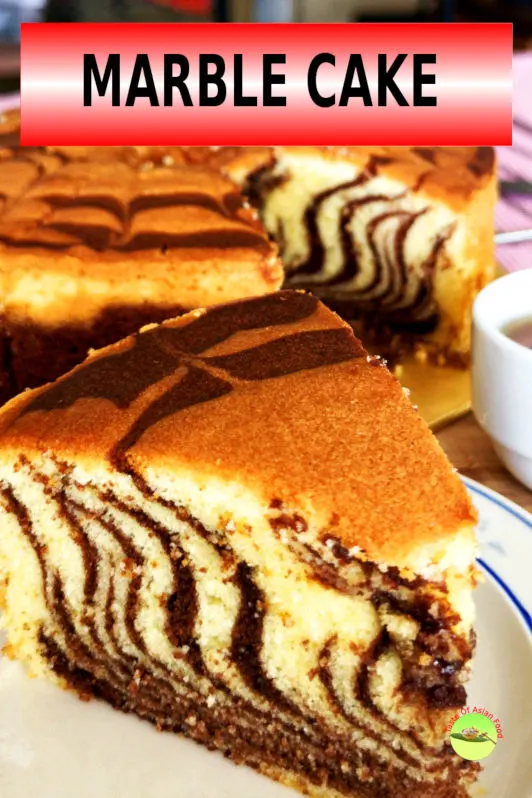
I will explain how I make my version of marble cake in this recipe. The process is similar to my butter cake recipe, except for the additional part of preparing the chocolate batter. You can call this recipe a chocolate pound cake.
You can read my in-depth discussion on how to make the best butter cake article on this blog, which is divided into two parts. Part one discusses the choice of ingredients and technique, and part two is a detailed explanation of the entire preparation and baking process.
Let’s get into the details right away.
Note: This post may contain affiliate links. Please read my privacy policy for more info. I may receive commissions for purchases made through links in this post. As an Amazon Associate, I earn from qualifying purchases.
How to make the best marble cake
1. Prepare the marble cake batter by using the creaming method
a. Use the best quality butter
It is vital to use good quality butter because it contributes the most flavor to the recipe. I prefer to use unsalted butter because I can control the saltiness. In general, the amount of salt in the salted butter is about one percent, which means if you have a block of butter weighing 250g, it will contain about 2.5g or half a teaspoon of salt. Omit the salt in this recipe if you use salted butter.
b. Make sure the butter is soft before starting the mixing process
I suggest you start making the cake by cutting the cold butter into cubes and keeping them in the large bowl. Before creaming it with the sugar, you must wait until the butter is soft. Hard butter does not cream well with sugar and will not trap enough air to raise the cake during baking. That is why we cut and placed the butter in the mixing bowl of our restaurant a day before so that we could start work immediately the next morning. Our staff does not need to wait for it to soften, which may take about an hour due to the large volume.
Add the sugar to the butter and start mixing once the butter is softened. Soft butter combines well with sugar to form a homogenous buttercream-like mixture. The mixing action traps air in the mix, eventually expanding in the oven and raising the cake.
The cake will rise higher if more air is trapped and yields a softer and fluffy texture. This process depends on a few factors:
- The softness of the butter. The softer the butter, the easier air will be trapped in the butter-sugar mixture.
- The best kind of sugar is castor because of its small granule size. You could also use granulated sugar, but it takes longer to cream the butter and sugar together since its granule size is bigger.
- The speed of mixing. Use medium to high speed to mix the butter and sugar to yield a smoother and lighter buttercream.
- Type of mixer attachment. The wire whisk attachment of the stand mixer is more efficient than the blade attachment in creating volume.
c. The duration required to cream the butter and sugar
The mixing time required depends on the four factors above; hence, it is impossible to recommend a fixed duration. It is more practical to decide when to stop mixing by looking at the appearance of the buttercream. Stop mixing when:
- The color of the butter turns from the initial bright to light yellow.
- It looks like soft ice cream.
- There is no more visible sugar granule in the mixture.
Note: If you are unsure whether you should stop mixing, just continue to mix it longer. There is no such thing as overmixing. No worry!
d. Add the eggs and milk
Add the milk and eggs only after the butter and sugar have turned into a smooth buttercream.
I pour ALL the eggs into the buttercream mixture while letting the mixer blade spin at high speed when I make cakes in my restaurant. However, I am a bit skeptical about doing so when I use a small handheld mixer at home. You will notice I add half of the egg in the video, followed by the remaining eggs. It is only my mental block, and I firmly believe it will not affect the result.
After you have added the eggs, it will look curdy initially. This appearance is common, and the mixture will eventually become smoother.
Once the eggs have thoroughly mixed with the butter and sugar, add the milk and continue mixing at medium to high speed until it becomes a smooth batter.
Again, the mixture will not be overmixed. If you are unsure, just mix it longer.
e. The dry ingredients for making the marble cake
Let me explain the flour, baking powder, and salt before we proceed to the next step.
- Flour. The cake is tender and moist if you use flour with lower protein content. This type of flour is usually labeled as cake flour. Avoid using flour with a high percentage of protein, called high protein flour or bread flour. The lower the protein content, the softer the cake will turn out. All-purpose flour can be used for this cake if you do not have low protein flour.
- Baking powder. This cake has a high amount of butter and will raise quite well without adding baking powder. However, since the chocolate batter is denser and harder to raise without baking powder, I have added two percent to the recipe. (Note: In this recipe, it is 300g of flour times 2 percent, that is 6g of baking powder.)
- Salt. As I mentioned, omit the salt in the recipe if you use salted butter. I use unsalted butter because I bake more often, and besides, I can control the amount of salt I need.
Note: You must omit the baking powder in the recipe if you use self-raising flour. Please check the ingredient printed on the box to check how much baking powder is included in the self-raising flour. In all cases, the amount of baking powder in the self-raising flour should be sufficient for this recipe.
f. Why is there no vanilla extract in the recipe?
You may wonder why I do not use vanilla essence like most other cake recipes.
The main reason is I can’t get a good quality vanilla essence where I live. Most of the ‘essence’ I found in the supermarket are artificial agents, which I think will do more harm than enhance the flavor.
Secondly, using vanilla extract with good quality butter and chocolate is unnecessary.
g. Combine the dry ingredients with the batter
As I mentioned earlier, there is no harm in mixing it longer than required, but not after adding the flour mixture.
Why?
The flour will react with the water in the batter and start to form gluten. Gluten is an elastic protein chain, just like rubber bands. The longer and more vigorous the mixing action, the more gluten will form, and the batter will become more rubbery. In other words, the cake will become more stretchy and lose its soft and tender texture. The most suitable mixer attachment is the paddle attachment, a low speed.
Therefore, the endpoint of mixing in the flour is when the flour is completely assimilated into the mixture, with no more visible specks of flour, and becomes a smooth batter. Once you get that texture, stop mixing. Scape the sides of the bowl manually to ensure all the flour is mixed with the batter.
Here is the image of what it looks like:
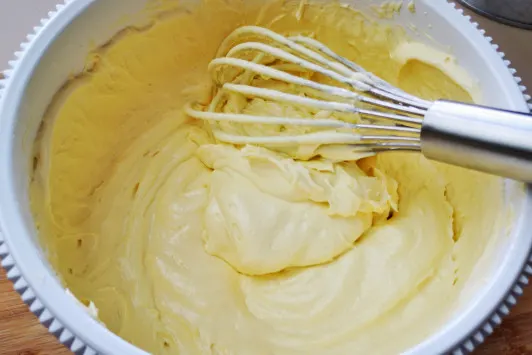
I add all the flour to the mixture when I use the high-power commercial mixer attached with a large wire whisk. I find that a wire whisk works better than a spatula and the blade attachment of the mixer.
Note: The above method of preparing the batter is nearly identical to my butter cake recipe. I also make banana cakes and orange cakes with a similar creaming technique. This butter cake article has an in-depth discussion on this topic for more details.
2. Preparing the chocolate batter for the marble cake
a. The best ratio between the butter and chocolate cake batter
The following part of this article is more specific to the marble cake.
I prefer to keep two- third of the cake batter, and use the remaining batter to mix with the chocolate to form the chocolate batter. You can use half of the batter if you want more chocolate present in the marble cake.
Break the chocolate into small pieces and place it in a large mixing bowl. Heat the chocolate over a pot of boiling water until it is nearly all melted. Remove from heat and keep stirring until the remaining chocolate is completely melted.
Once the chocolate is cold, add one-third of the cake batter to the chocolate and mix it until homogenous.
It is less messy to transfer the batter to the chocolate than to pour the melted chocolate into the cake batter!
b. Should I use chocolate or cocoa powder for making marble cake?
You can also use a good quality cocoa powder instead of melted chocolate. However, you need less cocoa powder than chocolate as it has a stronger flavor. I suggest substituting every thirty grams of chocolate with one tablespoonful of cocoa powder plus one tablespoon of milk. The additional milk is required because the cocoa powder will make the cake dryer.
I like marble cake made with dark chocolat. However, you can use chocolate chips or any chocolate block if you are not fuzzy.
3. Preparing the cake pan
I prefer to use cake pans with a detachable base or a springform pan because it is easier to unmold the cake. You can also use a loaf pan (those for bread) if you do not have the cake pan. Add a few drops of oil to the base before placing baking paper on it so that the paper will stick to the bottom.
There is no need to line the side of the cake pan with baking paper because the cake will not stick to it. This cake is rich in butter and will easily slip out from the mold.
4. Creating the marble effect of the cake
You can create different marbled patterns by changing the method of adding the batter into the cake pan.
- To create the zebra-like stripes. Add a scoop of the yellow cake batter to the center of the base, followed by a smaller scoop of chocolate batter. Continue stacking up the batter one on top of the other to form multiple cake layers. The batter will flow slowly to the side and fill the pan, and the layers will expand to the edge, forming the chocolate swirl. When you finish adding all the batters, tap the cake several times to smoothen the surface. Then use a wooden skewer or toothpick to draw some lines starting from the center to the side. (Please refer to the video in this article.)
- To form a patchy pattern, like a black and white cow. Scoop a large portion of the butter and chocolate batters alternatively and randomly into the cake pan.
5. Temperature and timing for baking the marble cake
Bake the marble cake in the preheated oven, middle rack at 175°C/350°F for about 50 minutes, or until the cake achieves the desired color.
The temperature in this recipe is for reference only since there are no two ovens behave precisely the same. The temperature indicated by the oven may not be accurate in some cases. Furthermore, the position of the heating elements can affect the temperature in the oven.
I would suggest baking the cake for at least fifty minutes until the inner part of the cake is thoroughly cooked. If the cake turns color at thirty minutes, you may want to reduce the temperature.
6. How to prevent cracks from forming in the marble cake?
The consistency of both batters is not identical because one contains chocolate. They will behave slightly differently and may not rise at the same speed. Therefore, the marble cake cracks more often than a pure butter cake.
The trick is to bake at a lower temperature. If cracks happen, you can try to bake it at 170°C/335°F for your next cake.
The crack will usually happen in the last ten minutes of baking. You can minimize the problem by setting your alarm clock to 40 minutes and observing the cake’s doneness. If the cake forms a dome too early, lowering the top temperature by 15°C can minimize the formation of cracks.
7. . Unmold the cake
To unmold the cake, place a cake board on top of it and flip it upended. Run the butter knife on all sides. The cake will slide out from the mold. Remove the bottom of the pan and the parchment paper. I do not cool it on the wire rack. Instead, place another cake board on the cake base and flip it over again.
Now you can cut it into wedges with a serrated knife to serve.
8. How long can I keep the marble cake?
This marble cake can be kept at room temperature (summer/tropical weather) for a day. You can extend the shelf life to 3-4 days by keeping it in plastic wrap and stored in the refrigerator. You also double wrap with two plastic bags and keep them in the freezer. The quality is as good as the newly baked cake for up to two weeks. Leave the frozen cake at room temperature overnight before consuming it.
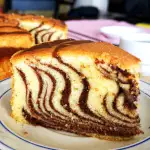
Marble Cake
Easy marble cake recipe. It is a pound cake recipe with chocolate streaks, soft, tender, moist. You don’t need a marble cake mix, just make from scratch!
Ingredients
- 330g (11.5 oz) butter
- 200g (7 oz) sugar
- 6 eggs (about 300g / 11.5 oz))
- 90ml (6 tbsp) milk
- 300g (11.5 oz) cake flour
- 1/2 tsp salt
- 5g (1 tsp) baking powder
- 80g (2.8 oz) chocolate
Instructions
- Place the softened butter in the bowl. Add the caster sugar and combine well.
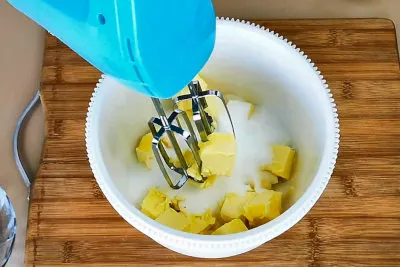
- Add the eggs gradually into the butter-sugar mixture. Add the milk. Continue beating until it becomes homogeneous.
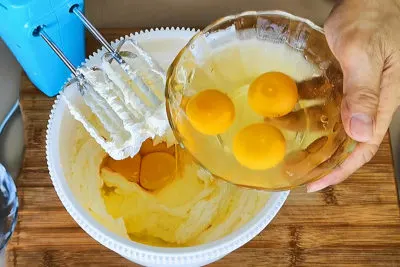
- Sieve the cake flour, salt, and baking powder in a large bowl. Combine well. Add the flour mix to the batter. Mix it until it becomes a smooth, creamy texture.

- Melt the chocolate over a pot of hot water, then combine the chocolate with the 1/3 of the batter.
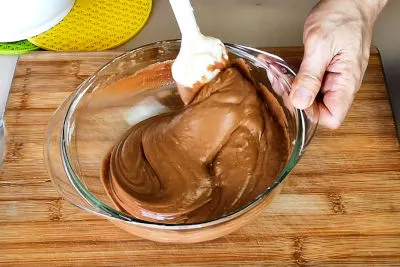
- Line the cake pan with baking paper. Place the yellow batter and the chocolate batter alternatively to the center of the pan.
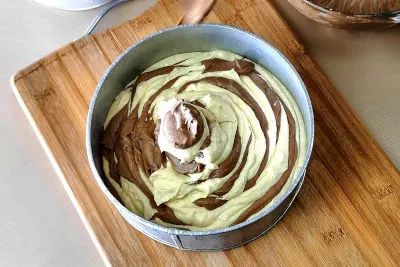
- Tap the cake pan a few times to smooth out the batter. Use a bamboo skewer to draw some lines to create the pattern.
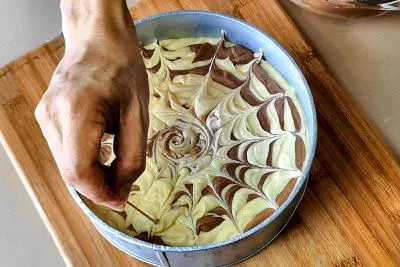
- Bake at 175 °C/350°F for 50 to 60 minutes.
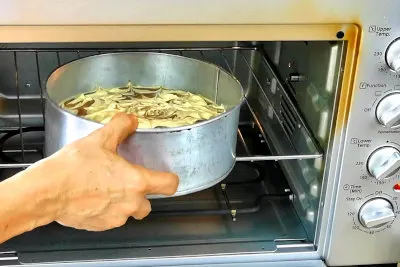
- Remove it from the cake pan. Cut into wedges and serve.
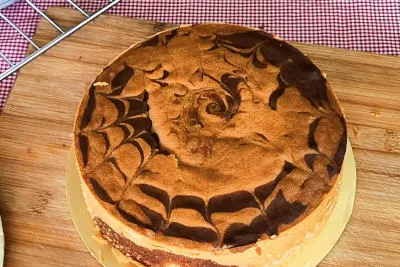
Recommended Products
As an Amazon Associate and member of other affiliate programs, I earn from qualifying purchases.
-
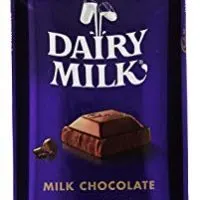 CADBURY Chocolate Candy Bar, Milk Chocolate, 3.5 Ounce (Pack of 14) Perfect for Easter
CADBURY Chocolate Candy Bar, Milk Chocolate, 3.5 Ounce (Pack of 14) Perfect for Easter -
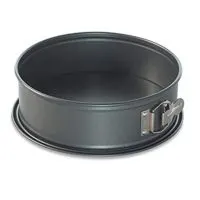 Nordic Ware Leakproof Springform Pan, 10 Cup, 9 Inch
Nordic Ware Leakproof Springform Pan, 10 Cup, 9 Inch -
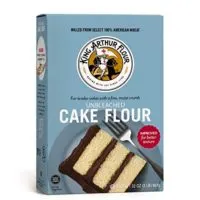 King Arthur Cake Flour, Unbleached, 2 lb
King Arthur Cake Flour, Unbleached, 2 lb -
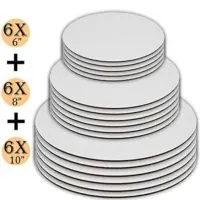 Cake Boards set of 18, Cake Boards 6 inch, Cake Boards 8 inch, and Cake Boards 10 Inch, 6 of each, Cake Board, Cake Base, Cardboard Cake Rounds, Cake Circles.
Cake Boards set of 18, Cake Boards 6 inch, Cake Boards 8 inch, and Cake Boards 10 Inch, 6 of each, Cake Board, Cake Base, Cardboard Cake Rounds, Cake Circles.
Nutrition Information:
Yield: 8 Serving Size: 1Amount Per Serving: Calories: 639Total Fat: 40gSaturated Fat: 24gTrans Fat: 1gUnsaturated Fat: 13gCholesterol: 231mgSodium: 542mgCarbohydrates: 61gFiber: 1gSugar: 30gProtein: 9g
This data was provided and calculated by Nutritionix on 4/7/2020

Ailin Ng
Friday 5th of January 2024
Super good. I baked it for Christmas. I would appreciate if you have fruit cake recipe too. Thanks again.
Sam Lowery
Sunday 10th of December 2023
Hi Kwan, Can I use semi-skimmed milk? Or are there any preferable types of kinds of milk which are good for Marble Cake? Then, how many tablespoons of cocoa powder and milk are required for the chocolate batter? I learned from you that substituting 30 grams of chocolate, for one tablespoon of cocoa powder plus another tablespoon of milk led me to the result of two tablespoons and two teaspoons of cocoa powder and milk equaling 40 grams. Can you confirm whether I am correct or not?
In addition, could I only use an electric hand mixer when mixing up all the ingredients? And you mentioned protein for the flour, specifically cake flour. Looking online, I consistently found roughly 10 grams or less protein in cake flour. What is the actual figure?
Thank you, Sam.
KP Kwan
Thursday 14th of December 2023
Hi Sam, - Semi-skimmed milk is OK for the cake, - I suggest using 2.5 tbsp cocoa powder and 2.5 tbsp milk (in addition to the 90ml milk in the recipe) to substitute the 80g of chocolate as in the recipe.
Vivian
Thursday 23rd of September 2021
Hi Kwan,
Just wanted to know what is the maximum water ratio for this cake. I plan to do a bigger cake but do not know how to do the calculation. What if I use 9” or 10” square pan?
Vivian
Sunday 3rd of September 2023
@kp Kwan, I thought the water ratio for an egg is 75%?
Vivian
Friday 20th of January 2023
@KP Kwan, what I mean is the water ratio for ur Buttercake is 120% maximum. The egg water ratio is only 75%. How about ur marble Buttercake? What is the maximum water ratio I can used to get a moist cake
KP Kwan
Friday 24th of September 2021
Hi Vivian, Not exactly sure what you are referring to the water ratio. I use 300g of flour and 390g of liquid (300 g eggs + 90g milk) and feel that is the maximum wet ingredients I can use. I used an 8” round cake pan in the recipe. I would use 1.5x of ingredients for a 9-inch square and 2x for a 10-inch square. I hope my calculation is correct:) KP Kwan
Sher
Tuesday 27th of July 2021
Hi! Mr Kwan Can I use a 6 inch mould if I halve the recipe? Thanks for sharing this great recipe.
Sher
Thursday 29th of July 2021
@KP Kwan, Thank you! I can't wait to bake try. It's the best tasting marble cake I have ever baked!
KP Kwan
Wednesday 28th of July 2021
It should be fine to do that. However, you may need a shorter baking time as it is smaller.
Okiki
Sunday 21st of February 2021
Simple procedure. I haven't tried it but will. My question is, can I add more milk?if yes, what measurements? Can I also use buttermilk in stead of Full cream milk? Can I use margarine in stead of butter( as butter is expensive where I am?. Thanks.
KP Kwan
Sunday 21st of February 2021
Hi Okiki, 1. The milk is sufficient by you can add another 2 tbsp to make it moist. Too much milk will throw the recipe out of balance. 2. Yes, you can use buttermilk. 3. Butter and margarine are interchangeable. It just that they taste slightly different. KP Kwan